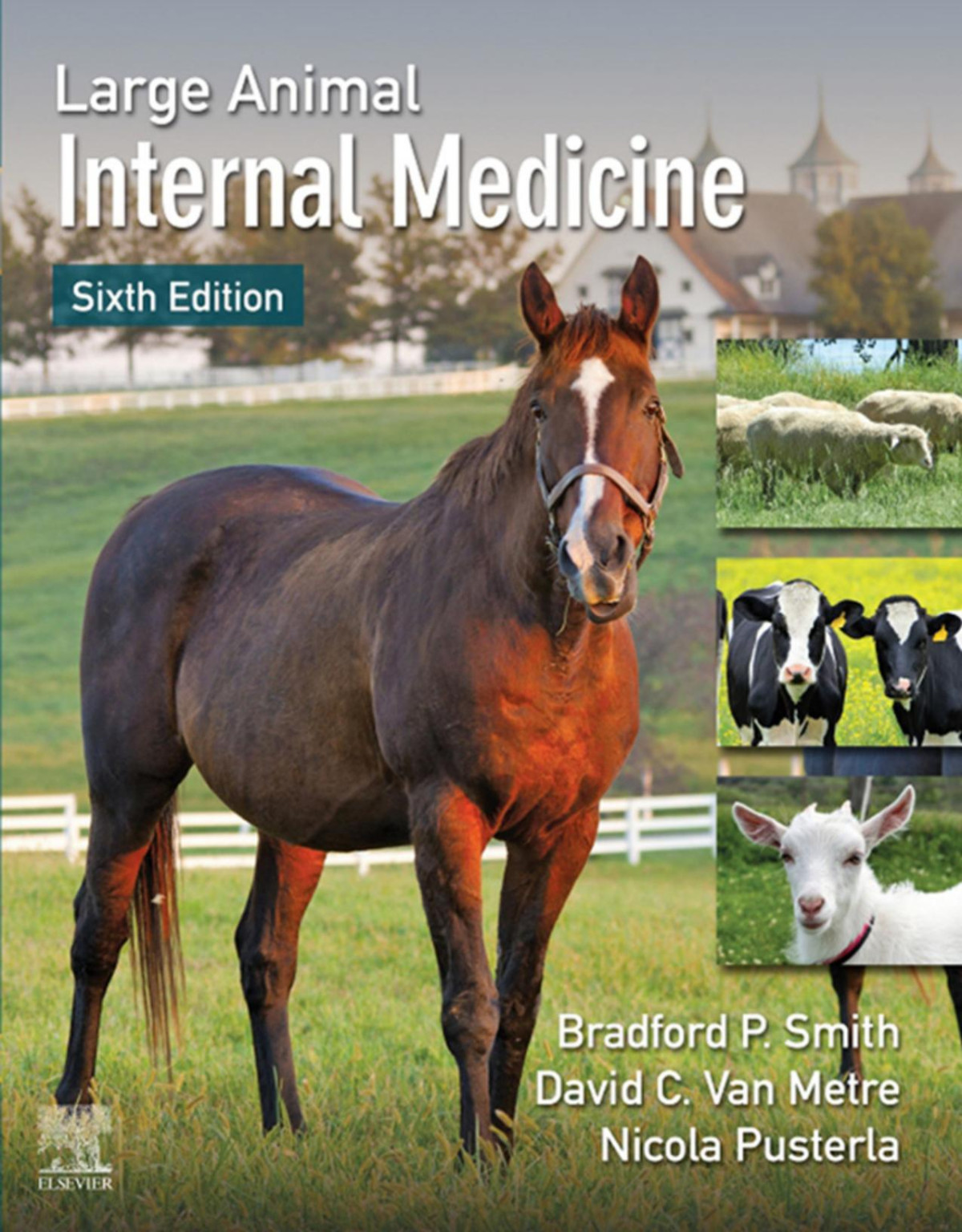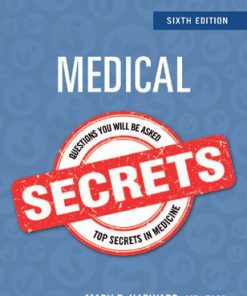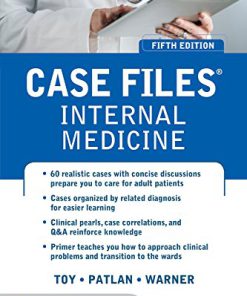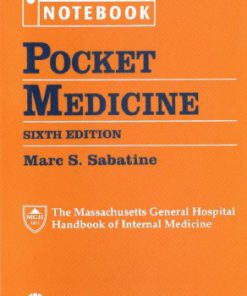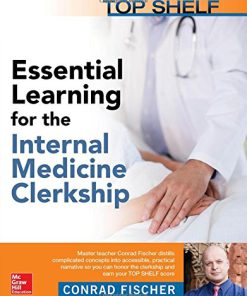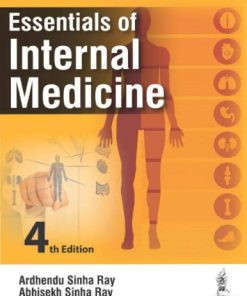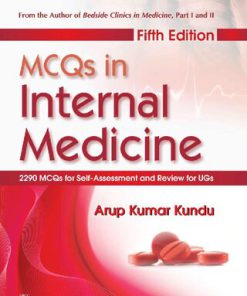Large Animal Internal Medicine 6th Edition by Bradford mith,Nicola Pusterla 0323554458 9780323554459
$50.00 Original price was: $50.00.$25.00Current price is: $25.00.
Large Animal Internal Medicine 6th Edition by Bradford mith,Nicola Pusterla – Ebook PDF Instant Download/Delivery:0323554458,9780323554459
Full download Large Animal Internal Medicine 6th Edition after payment
Product details:
ISBN 10:0323554458
ISBN 13: 9780323554459
Author:Bradford mith,Nicola Pusterla
**Selected for Doody’s Core Titles® 2024 with “Essential Purchase” designation in Veterinary Medicine** Utilize a problem-oriented approach to the diagnosis of diseases of horses, cattle, sheep, and goats. Large Animal Internal Medicine, 6th Edition covers the diagnosis and management of disease in both ruminant and equine internal medicine. As the first veterinary internal medicine text to use a problem-based approach, it offers discussions of over 150 clinical signs and manifestations, as well as comprehensive coverage of laboratory and diagnostic testing. New to this edition is a versatile online reference platform and coverage of conditions that exist in Europe, Central and South America, Australia, and New Zealand. In addition, thoroughly revised and updated content includes new vaccines and vaccination protocols; the most current laboratories for DNA, genetic, and PCR testing; and colostrum supplements and replacers. It’s everything you need to stay up to date with the latest information on preventing and treating disease in large animals.
- Discussions of over 150 clinical signs or manifestations of disease provide you with a problem-based approach to diagnosis based on what you’ve observed and what laboratory tests reveal.
- Causes of Presenting Signs boxes offer quick access to the common, less common, and uncommon diseases associated with manifestations or signs of disease.
- Causes of Abnormal Laboratory Values boxes highlight the possible interpretations of abnormalities in clinical chemistry, hematology, blood proteins, and clotting tests.
- More than 200 expert authors contribute information in their areas of expertise for the most current, authoritative information on each topic.
- NEW! Expert Consult platform provides a versatile digital resource including bonus content, useful references, and videos to meet the needs of practicing equine and large animal veterinarians.
- NEW! Global conditions of importance are covered, including those previously not discussed, that exist in Europe, Central and South America, Australia, and New Zealand.
- NEW! Coverage of emerging and re-emerging diseases includes the new pathogen discovery.
- NEW! Assessment of vaccination status and susceptibility to infection discusses how antibody titers can predict protection for some pathogens.
- NEW! Description of epigenetics and metagenomics provides detailed coverage of these emerging areas of interest.
- NEW! Table of zoonoses obtained from large animals includes symptoms and disinfection needs.
- NEW! Videos demonstrate how to perform ultrasound imaging on an equine and cow abdomen clearly showing where to position the probe, and what depth to use for scans of the kidneys, liver, and bowel.
- NEW! Coverage of genetic disorders, Hydrocephalus in Fresians and Pulmonary hypoplasia with Anasarca in Dexter cattle help you to treat these disorders.
- NEW! Extensively updated content clarifies the latest research and clinical findings on the West Nile Virus, therapeutic drug monitoring, muscle disorders, GI microbiota, the genetic basis for Immune-mediated myositis in Quarter Horses, discoveries in antimicrobial drugs, anthelmintic, and vaccines, and more!
Large Animal Internal Medicine 6th Table of contents:
Part 1 History, Physical Examination, and Medical Records
Introduction
• Chapter 1 Ruminant History, Physical Examination, Welfare Assessment, and Records
Obtaining the History
Examination
Medical Record
Diagnostic Tests That Can Be Applied in the Field
Assessing the Welfare of the Individual Animal or the Herd
Insurance, Interstate, and Prepurchase Health Examinations
References
• Chapter 2 Equine History, Physical Examination, Records, and Recognizing Abuse or Neglect in Patients*
Physical Examination Record
Equine Insurance
History
Physical Examination
Medical Record
Recognizing Abuse and Neglect in Equine Patients
Veterinarian’s Responsibility to Patient Welfare
References
Part 2 Manifestations of Disease
Introduction
• Chapter 3 Pain
Introduction
Diagnosing Pain in Livestock
Pharmacologic Interventions to Treat Livestock Pain
Summary
References
Further Reading
• Chapter 4 Alterations in Body Temperature
Control of Body Temperature
Conditions of Increased Body Temperature (Hyperthermia)
Fever
Fevers of Unknown Origin
Hypothermia
References
• Chapter 5 Alterations in Respiratory Function
Cough
Nasal Discharge
Epistaxis and Hemoptysis
Tachypnea
Respiratory Distress (Dyspnea)
Cyanosis
Abnormal Respiratory Noise (Stridor)
Exercise Intolerance and Poor Performance in Horses
References
• Chapter 6 Alterations in Cardiovascular and Hemolymphatic Systems*
Peripheral Edema, Pleural Effusion, and Ascites
Cardiac Arrhythmias
Cardiac Murmurs
Muffled Heart Sounds
Cardiovascular Exercise Intolerance, Weakness, and Syncope
Venous Distention and Pulsations
Painful Peripheral Swellings
Enlarged Lymph Nodes
Abnormal Peripheral Pulse
References
• Chapter 7 Alterations in Alimentary and Hepatic Function
Diarrhea
Colic
Melena
Blood, Fibrin, and/or Mucus in Feces (Dysentery)
Abdominal Distention and Constipation
Regurgitation and Vomiting
Dysphagia (Including Feed From Nares and Excessive Salivation)
Oral Vesicles, Erosions, Ulcers, or Growths
References
• Chapter 8 Localization and Differentiation of Neurologic Diseases
Terminology and Description of Clinical Signs of Neurologic Disease (See Table 8.1)
Diagnosis of Neurologic Diseases
Nervous System Examination
Localization of Central Nervous System Lesions
Localization of Neurologic Diseases by Major Clinical Signs
References
• Chapter 9 Alterations in Body Weight or Size
Mechanisms of Decreased Growth and Decreased Weight Gain
Weight Loss
Obesity
Pica
References
• Chapter 10 Alterations in Urinary Function
Dysuria, Stranguria, and Incontinence
Hematuria and Pigmenturia
Pyuria
Crystalluria
Polyuria
Anuria and Oliguria
Uremia
References
• Chapter 11 Alterations in the Skin*
General Approach to Diseases That Alter the Skin
Pruritus
Nodules, Tumors, and Swellings
Ulcerations and Erosions
Papules, Pustules, and Vesicles
Scaling and Crusting
Abnormal Coat Length and Density
Abnormal Pigmentation
References
• Chapter 12 Alterations in Sexual Function
Cyclic Irregularity
Anestrus
Repeat Breeder
Pregnancy Loss
Fescue Toxicosis
Prolonged Gestation
References
• Chapter 13 Musculoskeletal Abnormalities
Lameness and Stiffness
Postural Deformities
Swellings and Enlargements (Soft and Hard Tissue)
Swellings and Enlargements in Ruminants
Paresis and Weakness
Muscle Spasms and Myoclonus
Bibliography
• Chapter 14 Collapse and Sudden Death
Collapse Versus Sudden Death
Causes of Collapse and Sudden Death
References
Part 3 Disorders and Management of the Neonate
Introduction
• Chapter 15 The Equine Peripartum Period
Assessment of the Mare During Late Gestation
Effects of Placental Insufficiency
Placentitis
Systemic Disease in the Mare
Management of the High-Risk Late-Gestation Mare
Foal Resuscitation
Perinatal Asphyxia Syndrome
References
• Chapter 16 Assessment of the Newborn Foal
Neonatal Behavior
Maternal Behavior
Physical Assessment
References
• Chapter 17 Manifestations and Management of Disease in Neonatal Foals
General Principles of Treatment and Care of the Abnormal Foal
Sepsis
Septic Arthritis and Osteomyelitis
Noninfectious Causes of Lameness
Seizures
Neonatal Encephalopathy
Other Neurologic Conditions
Anemia
Maturity
Respiration
Diarrhea in Neonatal Foals
References
• Chapter 18 The Peripartum Ruminant
Late-Term Complications of Gestation
Assessment of Fetal Viability
Perinatal Adaptation
References
• Chapter 19 Initial Management and Clinical Investigation of Neonatal Ruminants
Environmental Management
Colostrogenesis and Colostral Components
Navel Treatment
Clinical Investigation of Neonatal Disease
References
• Chapter 20 Manifestations and Management of Disease in Neonatal Ruminants
Weakness and/or Depressed Mentation
Respiratory Difficulty
Abdominal Distention
Diarrhea
Lameness and Reluctance to Walk
Umbilical Enlargement
Anemia
Fever
Cyanosis
Heart Murmur
Icterus
Bleeding Disorders
Failure to Thrive: Cachexia and Weak Calf Syndrome
References
• Chapter 21 Colostrum and Milk Replacers
Colostrum Supplements and Replacements
Milk Replacers
References
Part 4 Collection of Samples and Interpretation of Laboratory Tests
Introduction
• Chapter 22 Clinical Chemistry Tests*
Submission of Laboratory Samples
Sources of Variation in Normal Values
Fluid and Electrolyte Balance
Acid-Base Imbalance (Traditional Approach or Hydrogen Ions–Centered Approach)
Serum Enzymes
Bilirubin
Glucose
Creatinine
Blood Urea Nitrogen
Serum Protein
Urinalysis
References
Useful Websites for Clinical Chemistry
• Chapter 23 Collection and Submission of Samples for Hematologic and Cytologic Evaluation*
Venipuncture Site and Technique
Handling and Transportation of Samples
General Principles for Submitting Cytology Samples
General Principles for Various Body Fluids
References
• Chapter 24 Alterations in the Erythron
Erythropoiesis
Laboratory Evaluation of Erythrocytes
Evaluation of the Anemic Patient
Erythrocytosis
References
• Chapter 25 Alterations in the Leukogram*
Leukocytes
Principles of Leukogram Interpretation
Approach to Interpretation of the Leukogram in Horses
Approach to Interpretation of the Leukogram in Ruminants
References
• Chapter 26 Alterations in Blood Proteins
Hyperproteinemia
The Acute Phase Response
Hypoproteinemia
References
• Chapter 27 Alterations in Hemostasis
Platelet Parameters
Thrombocytopenia
Thrombocytosis
Platelet Function Defects and Von Willebrand Disease
Prolonged Prothrombin Time
Prolonged Activated Partial Thromboplastin Time
Increased Fibrin and Fibrinogen Degradation Products
Decreased Plasma Antithrombin III
Hypofibrinogenemia
Thromboelastography
Other Tests of Hemostatic Function
References:
• Chapter 28 Collection and Analysis of Bone Marrow
Diagnostic Indications for Bone Marrow Aspiration or Biopsy
Bone Marrow Collection
Bone Marrow Evaluation
References
Color Plates
• Chapter 29 Molecular Diagnostics
Molecular Diagnostics in Large Animals
Molecular Testing for Infectious Diseases in Horses
Molecular Testing for Infectious Diseases in Cattle, Sheep, and Goats
References
Part 5 Disorders of the Organ Systems
Introduction
• Chapter 30 Diseases of the Cardiovascular System*
Performing the Electrocardiogram
Use of Echocardiography in Large Animals
Cardiac Catheterization in Large Animals
Congenital Cardiovascular Disease
Valvular Heart Disease
Brisket Disease, Cor Pulmonale, and Pulmonary Hypertension
Myocardial Disease: Myocarditis and Cardiomyopathy
Pericarditis
Cardiac Tumors
Vascular Disease: Aneurysms, Thrombosis, and Embolism
Atrial Fibrillation
Ventricular Tachycardia
References
• Chapter 31 Diseases of the Respiratory System
Disorders of the Lung
Diseases of Lymph Nodes, Vasculature, and Pharynx
Guttural Pouch Diseases
Diseases of the Paranasal Sinuses
Disorders of the Equine Soft Palate
Disorders of the Trachea
Upper Respiratory Tract Diseases*
Diseases of the Sinuses*
Diseases of the Pharynx, Larynx, and Trachea*
Lower Respiratory Tract Diseases*
The Interstitial Pneumonias*
Chronic Progressive Pneumonias of Sheep and Goats
Parasitic Bronchitis and Pneumonia*
Bovine Tuberculosis
Other Pneumonias*
Diseases of the Thoracic Wall and Cavity*
Miscellaneous Conditions*
References
Color Plates
• Chapter 32 Diseases of the Alimentary Tract
Examination and Imaging of the Equine Alimentary System
Ruminant Alimentary Disease
References
Color Plates
• Chapter 33 Diseases of the Hepatobiliary System
Diagnosis of Liver Disease*
Infectious, Toxic, and Parasitic Liver Disease
Hepatic Lipidosis*
Congenital Hyperbilirubinemia
Miscellaneous Liver Diseases
Gallbladder and Biliary Tract Disease
Therapy of Liver Failure
Pancreatic Disease
References
• Chapter 34 Diseases of the Renal System
Acute Renal Failure
Chronic Renal Failure
Ulcerative Posthitis and Vulvitis
Urolithiasis
Urachal Disorders
Urinary Bladder Eversion and Prolapse
Pelvic Entrapment of the Bladder
Enzootic Hematuria
Urinary Tract Infection
Amyloidosis
Glomerulonephritis
Congenital Defects
Neoplasia
Hemolytic Uremic Syndrome
Tubular Necrosis
Leptospirosis
References
• Chapter 35 Diseases of the Nervous System
Cerebrospinal Fluid
Electrodiagnostic Testing
Diseases Manifesting Principally With Forebrain Dysfunction or Multiple-Level Brain Dysfunction
Diseases Manifesting Principally With Brainstem and Cranial Nerve Dysfunction
Diseases Manifesting Principally With Spinal Cord or Peripheral Nerve Signs
References
• Chapter 36 Mammary Gland Health and Disorders
Mammary Gland Health of Dairy Cattle
Economic Impact of Mastitis of Dairy Cattle
Anatomic Structures of the Bovine Mammary Gland
Diagnosis and Detection of Mastitis
Prevention and Control of Mastitis
Mastitis Therapy: Antimicrobial Drugs
Mastitis in Beef Cows
Mastitis in Small Ruminants
Mastitis in Horses
References
• Chapter 37 Diseases of the Hematopoietic and Hemolymphatic Systems
Diseases Associated With Blood Loss or Hemostatic Dysfunction
Hemoperitoneum in Horses
Chronic Blood Loss
Gastric Ulceration
Hemostatic Dysfunction
Inherited Coagulation Disorders
Thrombasthenias
Acquired Hemostatic Disorders
Anaplasma Phagocytophila Infection in Horses
Thrombocytopenia
Disorders of Coagulation Factors
Diseases Associated With Increased Erythrocyte Destruction (Hemolytic Anemia)
Bovine Anaplasmosis
Babesiosis
Haemobartonellosis (Eperythrozoonosis)
Theileriasis
Leptospirosis
Bacillary Hemoglobinuria (Red Water)
Equine Infectious Anemia
Autoimmune Hemolytic Anemia
Neonatal Isoerythrolysis in Horse and Mule Foals
Intravascular Hemolysis Following Cutaneous Burns
l-Tryptophan-Indol Intoxication
Water Intoxication
Postparturient Hemoglobinuria
Hemolytic Syndrome in Horses With Liver Failure
Congenital Erythropoietic Porphyria
Depression Anemia
Iron Deficiency Anemia
Vitamin B12 and Folic Acid Deficiency
Anemia of Inflammatory Disease
Anemia Secondary to Organ Dysfunction
Myeloid and Megakaryocytic Bone Marrow Hypoplasia
Aplastic Anemia
Paradoxical Erythroid Hypoplasia
Erythrocytosis (Polycythemia)
Bovine Lymphoma
Lymphoma in Horses
Leukemia in the Horse
Myeloma in the Horse
Lymphangioma in the Horse
Anthrax
Lyme Disease
Tularemia
Corynebacterium pseudotuberculosis Infection
References
• Chapter 38 Diseases of the Bones, Joints, and Connective Tissues
Physitis (Epiphysitis)
Osteochondrosis
Angular Limb Deformities
Ovine Hereditary Chondrodysplasia (Spider Lamb Syndrome)
Septic (Infectious) Arthritis and Osteomyelitis
Mycoplasma Polyarthritis in Goats
Caprine Arthritis Encephalitis Virus
Osteoarthritis
Sprains, Subluxations, and Luxations
Arthrogryposis
Ankylosis
Osteomyelitis
Heel and Foot Pain
Spondylitis and Diskospondylitis
Spondylosis
Laminitis
Fluorosis
Hypertrophic Osteopathy
Fescue Foot
Interdigital Necrobacillosis (Foot Rot) in Cattle
Infectious Foot Rot in Small Ruminants
Other Infectious Conditions of the Foot
Fistulous Withers
Flexural Limb Deformities
Tendinitis
Suspensory Ligament Desmitis
Fractures
Spontaneous Fractures in Ruminants
Dorsal Metacarpal Disease in the Horse
Silicate Associated Osteoporosis
Temporohyoid Osteoarthropathy
References
• Chapter 39 Diseases of the Eye
Ophthalmic History and Examination*
Signs of Ocular Disease*
Ocular Trauma*
Infectious Ocular Diseases
Immune-Mediated Ocular Diseases
Ocular Parasites*
Ocular Neoplasia*
References
Color Plates
• Chapter 40 Diseases of the Skin*
Autoimmune Skin Disorders
Hypersensitivity Disorders
Bacterial Diseases
Viral Diseases
Fungal Diseases
Parasitic Skin Diseases
Tumors and Cysts
Environmental Diseases
Skin Disorders of Unknown or Genetic Origin
References
Color Plates
• Chapter 41 Endocrine and Metabolic Diseases
Pituitary and Hypothalamus
Adrenal Glands
Anhidrosis
Thyroid Gland
Equine Metabolic Syndrome
Endocrinopathic Laminitis
Parathyroid Gland, Calcium, and Phosphorus Regulation in Horses
Endocrine Dysfunction in Critical Illness
Macromineral and Bone Problems of Ruminants
Hyperketonemia in Dairy Cattle (Ketosis)
Bovine Somatotropin
References
• Chapter 42 Diseases of Muscle
Classification of Muscle Disorders
Disorders of Muscle Tone
Nonexertional Rhabdomyolysis
Exertional Myopathies in Horses
Hereditary and Congenital Myopathies
References
• Chapter 43 Diseases of the Reproductive System
Nonpathogenic Infertility
Infertility Caused by Abnormalities of the Female Genital Organs
Abnormalities of the Ovaries
Infertility Caused by Abnormalities of the Female Tubular Genitalia
Abortion
Infertility Caused by Diseases of the Penis and Prepuce
Infertility Caused by Diseases of the Scrotum and Testes
Infertility Caused by Diseases of the Spermatic Cord
Infertility Caused by Diseases of the Epididymis and Accessory Sex Glands
References
Part 6 Preventive and Therapeutic Strategies
Introduction
• Chapter 44 Critical Care and Fluid Therapy
Fluid Therapy in Ruminants
References
• Chapter 45 Rational Antimicrobial Therapy
Antimicrobial Stewardship
Medication Use in Food-Producing Animals
References
• Chapter 46 Biosecurity and Infection Control
How Much Is Enough? How Much Is Too Little?
Principles of Infection Control
Environmental Hygiene
Hand Hygiene
Barrier Protocols and Protective Attire
Animal Movement and Housing
Surveillance
Education and Awareness
Intervention and Investigation of Outbreaks of Health Care–Associated Infections
Infection Control Issues Related to Specific Pathogens
References
• Chapter 47 Prevention, Detection, and Response to Transboundary (Foreign) Animal Diseases
U.S. Department of Agriculture National Veterinary Accreditation Program
Overview of Foreign Animal Disease Investigation and Response
Future of Foreign Animal Disease Detection and Response
References
Other Valuable Foreign Animal Disease–Related Web Resources
• Chapter 48 Use of Biologics in the Prevention of Infectious Diseases
Current Concepts in Equine Vaccination and Infectious Disease Control
Ovine and Caprine Vaccination Programs
Bovine Vaccines and Herd Vaccination Programs
Bovine Herpesvirus Type 1: Infectious Bovine Rhinotracheitis Virus
Bovine Virus Diarrhea Virus Vaccines
Bovine Respiratory Syncytial Virus Vaccines
Parainfluenza Type 3 Virus Vaccines
Mannheimia haemolytica, Pasteurella multocida, Histophilus somni, and Bibersteinia trehalosi
Bovine Reproductive Disease Vaccines
Neonatal Calf Enteric Disease Vaccines
Bacterial Scours Vaccines
Clostridial Vaccines
Miscellaneous Bovine Rickettsial, Bacterial, and Viral Disease Vaccines
References
• Chapter 49 Parasite Control Programs
Equine Parasitic Disease
Gastrointestinal Nematode Infections in Cattle
Gastrointestinal Nematode Infections in Sheep and Goats
Evaluation of Parasite Control Programs
Lungworm Infection in Large Animals
Coccidiosis in Food Animals
Anthelmintic Use
Anthelmintic Drugs (see Table 49.4),
References
• Chapter 50 Nutrition of the Sick Animal
Introduction
Assessment of Nutritional Status
Nutritional Needs of Sick or Injured Large Animals
Nutritional Support of the Neonate
Enteral Routes of Nutritional Supplementation
Liquid Diets for Horses
Liquid Diets for Ruminants
Enteral Supplementation in Neonates
Parenteral Nutrition
Dextrose
Complex Parenteral Nutrition
Parenteral Nutrition in Ruminants
Conclusions
References
Part 7 Congenital, Hereditary, Immunologic, and Toxic Disorders
Introduction
• Chapter 51 Genetic Disorders
Genetic Information
Chromosomal Abnormalities
Breeding Schemes
Positive and Negative Selection
Recommendations for Breeding Programs
Obtaining Genetic Information
References
• Chapter 52 Genetic Tests for Large Animals
Individual Identification and Parentage Testing
Identifying Genetic Mutations
Disease Testing
References
• Chapter 53 Immunologic Disorders
Equine Immunologic Disorders
Diseases Caused by Allogeneic Incompatibilities (Horses and Ruminants)
Ruminant Immunologic Disorders
References
• Chapter 54 Disorders Caused by Toxicants*
Poisonous Plants
Metals and Other Inorganic Compounds
Medications, Therapeutic Agents, and Illicit Substances
Pesticides and Rodenticides
References
Color Plates
People also search for Large Animal Internal Medicine 6th:
large animal internal medicine salary
large animal internal medicine
large animal internal medicine residency
a large animal is composed of trillions of tiny
what are the big 6 animals
Tags:
Bradford mith,Nicola Pusterla,Internal,Medicine,Animal
You may also like…
Medicine - Veterinary Medicine
Medicine
Pocket Medicine The Massachusetts General Hospital Handbook of Internal Medicine Marc S. Sabbatine
Science (General)


